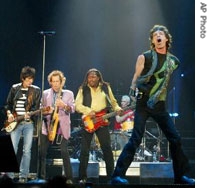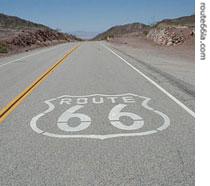-
(单词翻译:双击或拖选)
Welcome to AMERICAN MOSAIC1 in VOA Special English.
(MUSIC)
I’m Doug Johnson. On our show this week:
We play music from the new wave/punk band, the B-52’s …
Answer a listener’s question about the famous road called Route 66 …
And we "shine a light" on Martin Scorcese’s new movie about the Rolling Stones.
(MUSIC)
"Shine a Light"
HOST:
 |
| The Rolling Stones in concert |
American director Martin Scorsese makes popular movies that often deal with crime and violence. But he is also known for making movies about musicians that are important to him. His most recent movie is “Shine a Light.” It is about the British group some call the world’s greatest rock and roll band. The movie gives a close look at the energetic performances and timeless songs that have made the Rolling Stones famous. Faith Lapidus tells us more.
FAITH LAPIDUS:
The Rolling Stones are singer Mick Jagger, guitarist Keith Richards, drummer Charlie Watts2, and guitarist Ronnie Wood. These four rockers have been making music since the early nineteen sixties. They are the longest-lived rock group in history that is still performing.
(SOUND)
“Shine a Light” is mainly about two concerts the Rolling Stones gave at the Beacon3 Theatre in New York City in two thousand six. At first, the band and Scorsese thought the movie would show one the Rolling Stone’s large concerts attended by hundreds of thousands of people. But they decided4 it would be more interesting to show a concert in a smaller and more personal space.
Watching the movie is like being with the Rolling Stones on stage. The movie uses complex camera positions to artfully capture5 every angle6 of the musical action. You can see up close every dance movement and facial expression Mick Jagger makes. You can see the crowd cheering with excitement. But you also get to see what happens off stage. You see Mick Jagger thinking about what songs he will sing. You see Martin Scorsese wondering about what songs Jagger has chosen. And, you see the director discussing how the stage and lighting7 will look. You even get to see former president Bill Clinton go back stage before a concert to say hello to the Rolling Stones.
The movie also shows video recordings9 of the musicians when they were very young. In one video from the nineteen sixties, someone asks Mick Jagger how long he thinks the Rolling Stones will play music. Jagger guesses that the group might stay together another year.
Of course, the main subject of “Shine a Light” is the band’s music. The songs of the Rolling Stones remain as fresh and electric today as when they were first released10.
Route 66
HOST:
Our listener question this week comes from Dhaka, Bangladesh Shafiqul Islam wants to know about Route 66 and how it got its name.
Route Sixty-Six was the idea of Cyrus Avery, a businessman in Tulsa, Oklahoma. He helped create the system of numbered roads in the United States.  In the early nineteen twenties, Mister11 Avery proposed12 that the federal13 government build a road between Chicago, Illinois, and Los Angeles, California, along a southwestern path. The government agreed. In nineteen twenty-six the road was approved and officially named Route 66. The road is almost four thousand kilometers long and crosses eight states.
In the early nineteen twenties, Mister11 Avery proposed12 that the federal13 government build a road between Chicago, Illinois, and Los Angeles, California, along a southwestern path. The government agreed. In nineteen twenty-six the road was approved and officially named Route 66. The road is almost four thousand kilometers long and crosses eight states.
The naming of the famous highway was not easy. Cyrus Avery was firm in his wish that the road receive an even number. He favored the number sixty. But a group in the state of Kentucky loudly objected. It also sought a Route 60 to run along a different path.
Mister Avery then decided that the number sixty-six would serve well. He thought that the repeated six would be easy to remember and that sixty-six had a nice sound.
His decision was a good one. As far as we know there are no songs about Route 60, nor is it central in any books or movies. But Route 66 became a cultural symbol of an America on the move and in love with the automobile14.
The American writer John Steinbeck wrote about Route 66 in his famous book, “The Grapes of Wrath15.” He described it as the “mother road, the road of flight.” The characters in his book were people from Oklahoma who had lost their farms in severe dust storms in the nineteen thirties. They moved to California in search of a better life. They drove their vehicles with all their possessions along Route 66. The road has also been called the "Main Street of America" and the "People’s Road."
One song about 66 became especially famous. Songwriter Bobby Troup wrote the tune16 after a road trip with his wife in nineteen forty-six. Here is a little of Nat King Cole singing “Route 66.”
(MUSIC)
The “Mother Road” fell into disrepair in the nineteen sixties after the government decided to build larger high-speed roads called interstate highways. But for about the last twenty years, several groups have worked successfully for the renewal17 of Route 66.
The B-52's
HOST:
The B-52’s were a popular band in the punk/new wave style of rock music back in the nineteen eighties and early nineties. The group now has a new album out after a sixteen-year break in recording8. Barbara Klein plays a song from the new album and a few others from the past.
(MUSIC)
BARBARA KLEIN:
 |
| B-52's |
The B-52’s released that song, “Legal Tender,” in nineteen eighty-three, on the album “Whammy.” Like many of the band’s songs, “Legal Tender” is funny. And it has a great dance beat.
The B-52’s are Kate Pierson, Fred Schneider, Keith Strickland and Cindy Wilson. But at the time “Whammy” was released, Cindy Wilson’s brother, Ricky Wilson, was also in the band. All five formed the group while having drinks at a Chinese restaurant in Athens, Georgia.
Their first album, called “The B-52’s,” was released in nineteen seventy-nine. The song “Rock Lobster” went to number three on Billboard18 Magazine’s popular music chart. Here is “Dance This Mess Around,” another hit from the album.
(MUSIC)
Ricky Wilson died in nineteen eighty-five. For the next few years the band mourned and its work suffered. But in nineteen eighty-nine the B-52’s released “Cosmic Thing.” It became the group’s biggest album ever. Here is “Roam.”
(MUSIC)
The B-52’s say the new recording, “Funplex,” is modern. But band members say they will continue their tradition of crazy clothes and wild hair styles. Here is “Keep This Party Going.”
(MUSIC)
HOST:
I'm Doug Johnson. I hope you enjoyed our program today.
It was written Dana Demange and Caty Weaver19, who was also the producer
Join us again next week for AMERICAN MOSAIC, VOA’s radio magazine in Special English.
 收听单词发音
收听单词发音
1
mosaic

|
|
| n./adj.镶嵌细工的,镶嵌工艺品的,嵌花式的 | |
参考例句: |
|
|
|
2
watts

|
|
| (电力计量单位)瓦,瓦特( watt的名词复数 ) | |
参考例句: |
|
|
|
3
beacon

|
|
| n.烽火,(警告用的)闪火灯,灯塔 | |
参考例句: |
|
|
|
4
decided

|
|
| adj.决定了的,坚决的;明显的,明确的 | |
参考例句: |
|
|
|
5
capture

|
|
| vt.捕获,俘获;占领,夺得;n.抓住,捕获 | |
参考例句: |
|
|
|
6
angle

|
|
| n.角,角度,立场,观点 | |
参考例句: |
|
|
|
7
lighting

|
|
| n.照明,光线的明暗,舞台灯光 | |
参考例句: |
|
|
|
8
recording

|
|
| n.录音,记录 | |
参考例句: |
|
|
|
9
recordings

|
|
| n.记录( recording的名词复数 );录音;录像;唱片 | |
参考例句: |
|
|
|
10
released

|
|
| v.释放( release的过去式和过去分词 );放开;发布;发行 | |
参考例句: |
|
|
|
11
mister

|
|
| n.(略作Mr.全称很少用于书面)先生 | |
参考例句: |
|
|
|
12
proposed

|
|
| 被提议的 | |
参考例句: |
|
|
|
13
federal

|
|
| adj.联盟的;联邦的;(美国)联邦政府的 | |
参考例句: |
|
|
|
14
automobile

|
|
| n.汽车,机动车 | |
参考例句: |
|
|
|
15
wrath

|
|
| n.愤怒,愤慨,暴怒 | |
参考例句: |
|
|
|
16
tune

|
|
| n.调子;和谐,协调;v.调音,调节,调整 | |
参考例句: |
|
|
|
17
renewal

|
|
| adj.(契约)延期,续订,更新,复活,重来 | |
参考例句: |
|
|
|
18
billboard

|
|
| n.布告板,揭示栏,广告牌 | |
参考例句: |
|
|
|
19
weaver

|
|
| n.织布工;编织者 | |
参考例句: |
|
|
|















